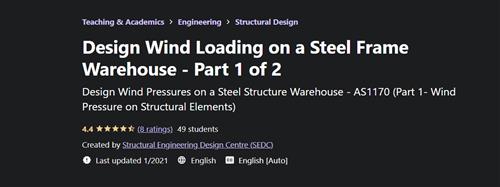MP4 | Video: h264, 1280×720 | Audio: AAC, 44.1 KHz, 2 Ch
Genre: eLearning | Language: English + srt | Duration: 13 lectures (1h 50m) | Size: 534.2 MB
Design Wind Pressures on a Steel Structure Warehouse – AS1170 (Part 1- Wind Pressure on Structural Elements)
What you’ll learn
Basics and general concepts of wind load on structures
Regional wind speed for different areas of the country
Terrain/height multiplier and explaining the definition of different train categories
Defining Importance level of the building and return period of the wind considering the occupancy and use of the building
Wind direction multiplier / Hill-shape multiplier/ Shielding multiplier
Site wind speed for eight cardinal directions / Design wind speed for the four major directions of the structure
Aerodynamic shape factor for different surfaces or parts of the building
Design wind pressure on structural elements of the walls and roof for different portal frames of this warehouse for the 4 major directions of the structure
Frictional Drag on Roof and Side Walls
Requirements
N/A – Whole process has been explained in a very basic level
Description
In this course, I will explain the full and detailed process of calculating the design wind pressures for structural members and cladding surfaces of the walls and roof of a steel-framed warehouse.
The assessment of wind loads for the design of structures is based on Australia/New Zealand standard AS1170.2 however the general concept remains the same for every other code.
AS1170 has a very detailed and comprehensive process for calculating wind pressures.
There are so many parameters and requirements in the code which often leaves people with some confusion and question marks on how to approach these. so I have decided to prepare this course to provide a clear roadmap for anyone who wants to learn the process step by step.
This course, "Design Wind Pressures on a Steel Structure Warehouse" includes two parts
Please make sure to watch both parts to learn the whole design process.
In the first part of this course, you will learn
about the basics and general concepts of wind loading on structures within our practical and real-life example and also I will explain about how to calculate the wind parameters and where in the code I am getting these values from. These parameters include
– Regional wind speed for different areas of the country,
-Terrain/height multiplier and explaining the definition of different train categories,
– Defining Importance level of the buildings and return period of the wind considering the occupancy and use of the building
– Wind direction multiplier,
– Hill-shape multiplier,
– Shielding multiplier
– Site wind speed
– Design wind speed
– Aerodynamic shape factor for different surfaces or parts of the building.
Calculating aerodynamic shape factor requires calculating the external and internal pressure coefficients, area reduction factor, local pressure factor, action combination factor, permeable cladding factor, and dynamic response factor.
These factors have to be determined for windward walls, Leeward walls, sidewalls, roof structure, and cladding surfaces of the walls and roof with respect to wind on 4 major axes of the structure.
– Design wind pressure on structural elements of the walls and roof for different portal frames of this warehouse for the 4 major axes of the structure.
– Frictional Drag forces on Roof and Side Walls.
– How wind pressure changes along the roof and long walls.
In part 2, I will explain
– Design wind pressure on doors and windows and how the size of the opening can impact the net wind pressure on wall and roof surfaces.
– Design wind pressure on wall claddings and supporting structures and how to calculate localized wind pressures on walls claddings
– Design wind pressure on roof claddings and supporting structures and how to calculate localized wind pressures on roof claddings.
– Evaluating the impact of the big openings on internal and net wind pressure on cladding surfaces of the roof and walls.
– How wind pressure changes along the roof and long walls.
– Summary of the net wind pressure on different areas of the roof.
By the end of these two courses, you will learn about the fundamental and full and detailed process of calculating the wind pressure for structural members and claddings surfaces of the walls and roof of a steel-framed warehouse.
My goal is to add value to my students by conveying my professional/practical experience as well as explaining the theoretical concept behind the design, so please do not hesitate to ask if you ask any questions through the message box here or any other social media links which are provided in our page.
Also, you will have lifetime access to the course content which means you will receive all future updates and additions free of charge.
Who this course is for
Structural engineers ranging from beginners to intermediate level who would like to refresh their knowledge and get a practical knowledge of wind loading on structures
Graduate engineers
Structural engineering students
Civil engineering students
Homepage
https://www.udemy.com/course/design-wind-pressures-on-a-steel-structure-warehouse-part-1/
DOWNLOAD FROM UPLOADGIG.COM
DOWNLOAD FROM RAPIDGATOR.NET
DOWNLOAD FROM NITROFLARE.COM




